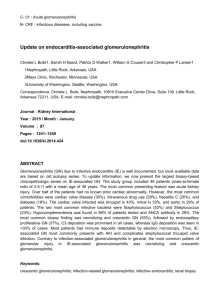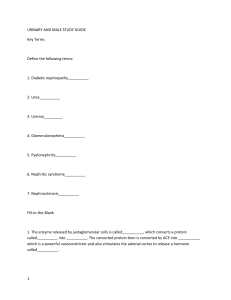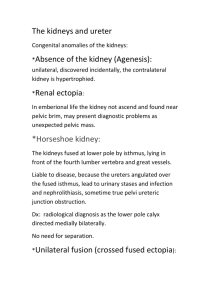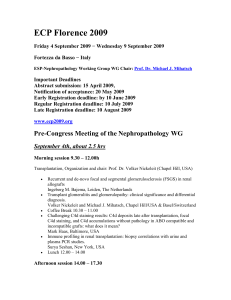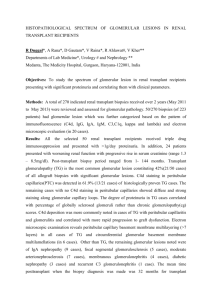Anti-Glomerular Basement Membrane (GBM) Nephritis
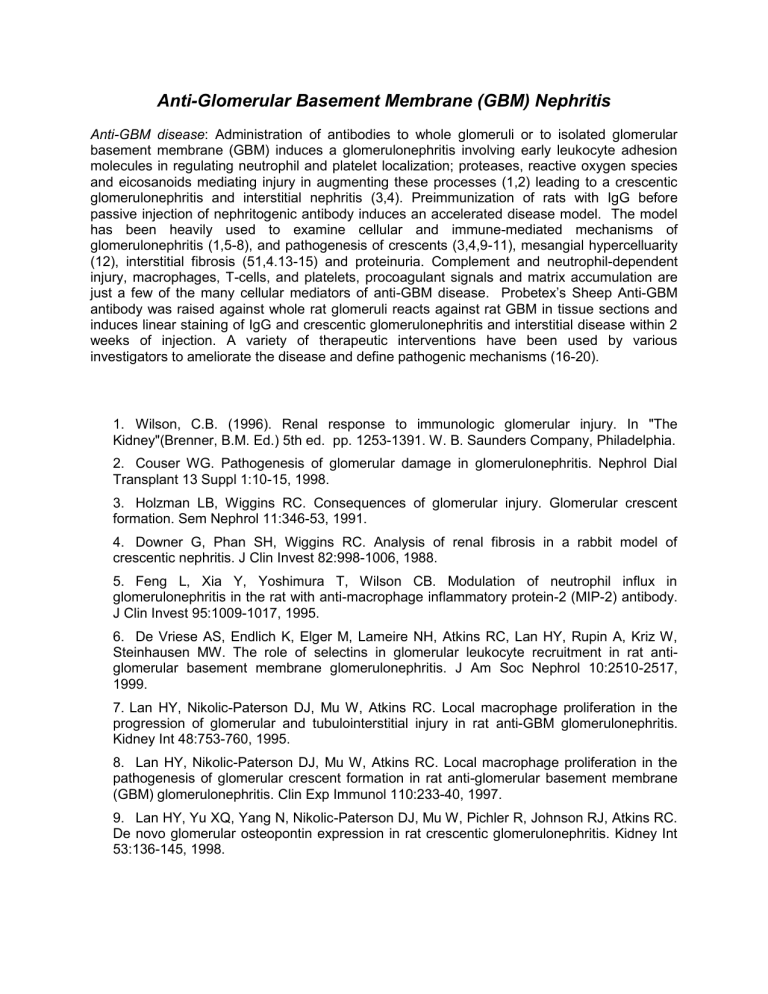
Anti-Glomerular Basement Membrane (GBM) Nephritis
Anti-GBM disease : Administration of antibodies to whole glomeruli or to isolated glomerular basement membrane (GBM) induces a glomerulonephritis involving early leukocyte adhesion molecules in regulating neutrophil and platelet localization; proteases, reactive oxygen species and eicosanoids mediating injury in augmenting these processes (1,2) leading to a crescentic glomerulonephritis and interstitial nephritis (3,4). Preimmunization of rats with IgG before passive injection of nephritogenic antibody induces an accelerated disease model. The model has been heavily used to examine cellular and immune-mediated mechanisms of glomerulonephritis (1,5-8), and pathogenesis of crescents (3,4,9-11), mesangial hypercelluarity
(12), interstitial fibrosis (51,4.13-15) and proteinuria. Complement and neutrophil-dependent injury, macrophages, T-cells, and platelets, procoagulant signals and matrix accumulation are just a few of the many cellular mediators of anti-GBM dis ease. Probetex’s Sheep Anti-GBM antibody was raised against whole rat glomeruli reacts against rat GBM in tissue sections and induces linear staining of IgG and crescentic glomerulonephritis and interstitial disease within 2 weeks of injection. A variety of therapeutic interventions have been used by various investigators to ameliorate the disease and define pathogenic mechanisms (16-20).
1. Wilson, C.B. (1996). Renal response to immunologic glomerular injury. In "The
Kidney"(Brenner, B.M. Ed.) 5th ed. pp. 1253-1391. W. B. Saunders Company, Philadelphia.
2. Couser WG. Pathogenesis of glomerular damage in glomerulonephritis. Nephrol Dial
Transplant 13 Suppl 1:10-15, 1998.
3. Holzman LB, Wiggins RC. Consequences of glomerular injury. Glomerular crescent formation. Sem Nephrol 11:346-53, 1991.
4. Downer G, Phan SH, Wiggins RC. Analysis of renal fibrosis in a rabbit model of crescentic nephritis. J Clin Invest 82:998-1006, 1988.
5. Feng L, Xia Y, Yoshimura T, Wilson CB. Modulation of neutrophil influx in glomerulonephritis in the rat with anti-macrophage inflammatory protein-2 (MIP-2) antibody.
J Clin Invest 95:1009-1017, 1995.
6. De Vriese AS, Endlich K, Elger M, Lameire NH, Atkins RC, Lan HY, Rupin A, Kriz W,
Steinhausen MW. The role of selectins in glomerular leukocyte recruitment in rat antiglomerular basement membrane glomerulonephritis. J Am Soc Nephrol 10:2510-2517,
1999.
7. Lan HY, Nikolic-Paterson DJ, Mu W, Atkins RC. Local macrophage proliferation in the progression of glomerular and tubulointerstitial injury in rat anti-GBM glomerulonephritis.
Kidney Int 48:753-760, 1995.
8. Lan HY, Nikolic-Paterson DJ, Mu W, Atkins RC. Local macrophage proliferation in the pathogenesis of glomerular crescent formation in rat anti-glomerular basement membrane
(GBM) glomerulonephritis. Clin Exp Immunol 110:233-40, 1997.
9. Lan HY, Yu XQ, Yang N, Nikolic-Paterson DJ, Mu W, Pichler R, Johnson RJ, Atkins RC.
De novo glomerular osteopontin expression in rat crescentic glomerulonephritis. Kidney Int
53:136-145, 1998.
10. Yu XQ, Fan JM, Nikolic-Paterson DJ, Yang N, Mu W, Pichler R, Johnson RJ, Atkins RC,
Lan HY. IL-1 up-regulates osteopontin expression in experimental crescentic glomerulonephritis in the rat. Am J Pathol 154:833-841, 1999.
11. Hayashi K, Horikoshi S, Osada S, Shofuda I, Tomino Y: Macrophage-derived MT1-MMP and increased MMP-2 activity are associated with glomerular damage in crescentic glomerulonephritis J. Pathol 191: 299-305, 2000.
12.
Bokemeyer D, Guglielmi KE, McGinty A, Sorokin A, Lianos EA, Dunn MJ. Activation of extracellular signal-regulated kinase in proliferative glomerulonephritis in rats. J Clin Invest
100:582-588, 1997.
13. Feng L, Loskutoff DJ, Wilson CB. Glomerular extracellular matrix accumulation in experimental anti-GBM Ab glomerulonephritis. Nephron 84:40-8, 2000.
14. Pichler R, Giachelli CM, Lombardi D, Pippin J, Gordon K, Alpers CE, Schwartz SM,
Johnson RJ. Tubulointerstitial disease in glomerulonephritis. Potential role of osteopontin
(uropontin). Am J Pathol 144:915-926, 1994.
15. Barnes VL, Musa J, Mitchell RJ, Barnes JL. Expression of embryonic fibronectin isoform
EIIIA parallels alpha-smooth muscle actin in maturing and diseased kidney. J Histochem
Cytochem 47:787-798, 1999.
16. Ogawa D, Shikata K, Matsuda M, Okada S, Usui H, Wada J. Taniguchi N. Makino H.
Protective effect of a novel and selective inhibitor of inducible nitric oxide synthase on experimental crescentic glomerulonephritis in WKY rats. Nephrol Dial Transplant 17:2117-
21, 2002.
17. Khan SB. Cook HT. Bhangal G. Smith J. Tam FW. Pusey CD. Antibody blockade of
TNF-alpha reduces inflammation and scarring in experimental crescentic glomerulonephritis.
Kidney Int 67:1812-20, 2005.
18. Saga D, Sakatsume M, Ogawa A, Tsubata Y, Kaneko Y, Kuroda T, Sato F, Ajiro J,
Kondo D, Miida T, Narita I, Gejyo F. Bezafibrate suppresses rat antiglomerular basement membrane crescentic glomerulonephritis. Kidney Int 67:1821-9, 2005.
19. Levidiotis V. Freeman C. Tikellis C. Cooper ME. Power DA. Heparanase inhibition reduces proteinuria in a model of accelerated anti-glomerular basement membrane antibody disease. Nephrology. 10:167-73, 2005.
20. Leh S, Vaagnes O, Margolin SB, Iversen BM, Forslund T. Pirfenidone and candesartan ameliorate morphological damage in mild chronic anti-GBM nephritis in rats . Nephrol Dial
Transplant 20:71-82, 2005.
Interstitial Fibrosis (Obstructive Nephropathy)
Unilateral Ureteral Obstruction: Renal injury in this model is initiated by performing a midline abdominal incision, reflecting the viscera, and ligating the left renal ureter in two separate points
(1, all references below). The surgical wound is closed and the rats are returned to their cages
At three time points 3 days, 1 week and 2 weeks after UUO, representing early, mid, and late time points of disease progression, the rats are anesthetized and kidneys removed sliced and processed for fresh frozen and paraformaldehyde-fixed paraffin sections of whole kidney for histological analysis and whole kidney protein lysates and RNA as described above and in general methods section. UUO results in progressive interstitial disease with limited glomerular involvement, thus isolation of glomeruli will not be performed.
Disease characteristics:
UUO results in progressive interstitial disease with limited glomerular involvement (1). The disease is characterized by increased interstitial hypercellularity (myofibroblast encroachment), accumulation of extracellular matrix, tubular atrophy and inflammatory cell (primarily macrophage) infiltration (1-5). Because the disease is unilateral, the contralateral non-UUO kidney can be used as a control. However, there are physiological changes in this kidney, because of the increased functional load required to maintain homeostasis. In that regard compensatory function of the right kidney minimizes any functional impairment that can be detected by urinalysis and serum concentrations of BUN and creatinine, thus renal functional parameters remain normal or slightly altered, despite a severe interstitial disease in the left UUO kidney. Therefore, serum and urine collections are not helpful in determining severity of the disease. Determination of disease severity and interventional assessment must ultimately rely on histopathological analysis.
The model has been used extensively for drug interventional studies to determine mechananisms of disease and efficacy of therapeutic approaches (references 6-12 to mention a few).
1. Nagle RB, Bulger RE. Unilateral obstructive nephropathy in the rabbit. II. Late morphologic changes. Lab Invest 38:270-278, 1978.
2. Kaneto H. Morrissey J. McCracken R. Reyes A. Klahr S. Osteopontin expression in the kidney during unilateral ureteral obstruction. [Journal Article. Research Support, U.S. Gov't,
P.H.S.] Mineral & Electrolyte Metabolism. 24(4):227-37, 1998
3. Sutaria PM. Ohebshalom M. McCaffrey TA. Vaughan ED Jr. Felsen D. Transforming growth factor-beta receptor types I and II are expressed in renal tubules and are increased after chronic unilateral ureteral obstruction. Life Sciences. 62(21):1965-72, 1998
4. Yamate J. Okado A. Kuwamura M. Tsukamoto Y. Ohashi F. Kiso Y. Nakatsuji S. Kotani T.
Sakuma S. Lamarre J. Immunohistochemical analysis of macrophages, myofibroblasts, and transforming growth factor-beta localization during rat renal interstitial fibrosis following longterm unilateral ureteral obstruction. Toxicologic Pathology. 26(6):793-801, 1998
5. Fu P. Liu F. Su S. Wang W. Huang XR. Entman ML. Schwartz RJ. Wei L. Lan HY.
Signaling mechanism of renal fibrosis in unilateral ureteral obstructive kidney disease in ROCK1 knockout mice. Journal of the American Society of Nephrology. 17(11):3105-14, 2006
6. Sakai T. Kawamura T. Shirasawa T. Mizoribine improves renal tubulointerstitial fibrosis in unilateral ureteral obstruction (UUO)-treated rat by inhibiting the infiltration of macrophages and the expression of alpha-smooth muscle actin. Journal of Urology. 158(6):2316-22, 1997
7. Shimizu T. Kuroda T. Hata S. Fukagawa M. Margolin SB. Kurokawa K. Pirfenidone improves renal function and fibrosis in the post-obstructed kidney. Kidney International.
54(1):99-109, 1998
8. Goncalves RG. Biato MA. Colosimo RD. Martinusso CA. Pecly ID. Farias EK. Cardoso
LR. Takiya CM. Ornellas JF. Leite M Jr. Effects of mycophenolate mofetil and lisinopril on collagen deposition in unilateral ureteral obstruction in rats. American Journal of Nephrology.
24(5):527-36, 2004
9. Mizuguchi Y. Miyajima A. Kosaka T. Asano T. Asano T. Hayakawa M. Atorvastatin ameliorates renal tissue damage in unilateral ureteral obstruction. Journal of Urology. 172(6 Pt
1):2456-9, 2004
10. Esteban V. Lorenzo O. Ruperez M. Suzuki Y. Mezzano S. Blanco J. Kretzler M. Sugaya
T. Egido J. Ruiz-Ortega M. Angiotensin II, via AT1 and AT2 receptors and NF-kappaB pathway, regulates the inflammatory response in unilateral ureteral obstruction. Journal of the American
Society of Nephrology. 15(6):1514-29, 2004
11. Manucha W. Oliveros L. Carrizo L. Seltzer A. Valles P. Losartan modulation on NOS isoforms and COX-2 expression in early renal fibrogenesis in unilateral obstruction. Kidney
International. 65(6):2091-107, 2004
12. Odani H. Asami J. Ishii A. Oide K. Sudo T. Nakamura A. Miyata N. Otsuka N. Maeda K.
Nakagawa J. Suppression of renal alpha-dicarbonyl compounds generated following ureteral obstruction by kidney-specific alpha-dicarbonyl/L-xylulose reductase. Annals of the New York
Academy of Sciences. 1126:320-4, 2008

